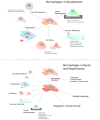Metchnikoff's policemen: macrophages in development, homeostasis and regeneration
- PMID: 21890411
- PMCID: PMC3225647
- DOI: 10.1016/j.molmed.2011.07.009
Metchnikoff's policemen: macrophages in development, homeostasis and regeneration
Abstract
Over the past decade, modern genetic tools have permitted scientists to study the function of myeloid lineage cells, including macrophages, as never before. Macrophages were first detected more than a century ago as cells that ingested bacteria and other microbes, but it is now known that their functional roles are far more numerous. In this review, we focus on the prevailing functions of macrophages beyond their role in innate immunity. We highlight examples of macrophages acting as regulators of development, tissue homoeostasis, remodeling (the reorganization or renovation of existing tissues) and repair. We also detail how modern genetic tools have facilitated new insights into these mysterious cells.
Copyright © 2011 Elsevier Ltd. All rights reserved.
Figures


References
-
- Dzik JM. The ancestry and cumulative evolution of immune reactions. Acta Biochim Pol. 2010;57:443–466. - PubMed
-
- Tauber AI. Metchnikoff and the phagocytosis theory. Nat Rev Mol Cell Biol. 2003;4:897–901. - PubMed
-
- Metchnikoff E. Lectures on the comparative pathology of inflammation; delivered at the Pasteur Institute in 1891. Dover Publications; 1968.
Publication types
MeSH terms
Grants and funding
LinkOut - more resources
Full Text Sources
Other Literature Sources
Miscellaneous

